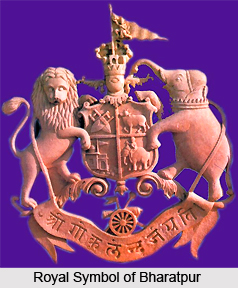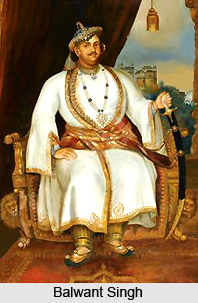 The history of Bharatpur is a history of power struggles. It began with the significant end of the Mughal power and marked the emergence of the glorious kingdom of the Jats as well. With the indomitable spirit and invincible courage of the Jat rulers like Suraj Mai and Jashwant Singh the kingdom reached its zenith of fame and splendour. Be it the Rajputs or the British, the Jats outshown them all. But after the reign of Raja Ranjeet Singh troubles started cropping up in the royal household of the Jats as well as with the British and by the year1825 the British brought Bharatpur under their supremacy.
The history of Bharatpur is a history of power struggles. It began with the significant end of the Mughal power and marked the emergence of the glorious kingdom of the Jats as well. With the indomitable spirit and invincible courage of the Jat rulers like Suraj Mai and Jashwant Singh the kingdom reached its zenith of fame and splendour. Be it the Rajputs or the British, the Jats outshown them all. But after the reign of Raja Ranjeet Singh troubles started cropping up in the royal household of the Jats as well as with the British and by the year1825 the British brought Bharatpur under their supremacy.
In the year 1805, the British under the leadership of General Lake, failed to capture Bharatpur and thus entered into a treaty. According to the treaty in 1805 between Raja Ranjeet Singh and the British Government, re-established the state Bharatpur . Ranjit Singh died in Govardhan eight months after the termination of the treaty. He left behind four sons—Randhir Singh, Baldeo Singh, Prithvi Singh and Lachhman Singh who enjoyed the restoration of Bharatpur till the integration of Indian state into Indian union. Maharaja Randhir Singh ascended the throne after the death of his father and ruled from 1805 to1823 AD. This period witnessed conflict and rupture as well as friendship between the Bharatpur house and the British. Randhir Singh proved to be an able administrator and maintained peace and harmony in his state. He left behind no issues and hence was succeeded by his younger brother Baldeo Singh, who ruled the state very briefly till his death in 1825.
Immediately after Baldeo Singh"s ascension to the throne of Bharatpur, troubles started cropping up in the ruling house. Durjan Sal, the adopted son of the late Raja Randhir Singh claimed the throne, but the British Government acknowledged Baldeo Singh as Raja, as the latter had bribed David Ochterlony, the British agent at Delhi Rani Laxmi, the widow of Randhir Singh was an ambitious lady and wanted to retain power in her hand. She left no stone unturned to get her adopted son Durjan Sal seated on the desirable throne of Bharatpur but Baldeo Singh, supported by the British, imprisoned Durjan Sal. Fearing trouble from the Rani, Baldeo Singh accused her of refusing to hand over keys of state treasury and exiled her in Vrindavan
This was a territory of the Government of the East India Company and the Rani faced harassment from the officials of the Raja there. After the death of Baldeo Singh trouble broke out like wildfire. This provided a pretext to the English to interfere in the affairs of the state in 1825-26 not to defend the right of the minor chief Balwant Singh, but as a matter of policy. Since 1805, the Britishers were apprehensively eyeing the great Jat fortress and these internal dissensions provided the right opportunity to the British Government. Durjan Sal was also waiting for the right opportunity and as soon as the news of usurpation of the throne of Bharatpur by Durjan Sal came to Delhi, the British Resident Ochterlony, right away collected a large force to march upon Bharatpur. He also issued a proclamation, calling upon the people of Bharatpur not to desert their rightful sovereign Raja Balwant Singh, who would be supported by the British Government in India by military force. In the mean time Durjan Sal sent a reconciliatory letter to the Governor-General-in-Council, who ordered the British army to retreat.
 Ochterlony resigned after this incident and was succeeded by Metcalfe who convinced the Governor-General-in-Council that the use of force was the only remedy to realize their long-cherished goal— the capture of Lohagarh (the Bharatpur fort). Thus in 1825, the Governor-General-in-Council passed a resolution saying that their interference was necessary to retain peace and harmony in Bharatpur. The Lohagarh (fort of Bharatpur) got ready again to face the assault of the enemy. Durjan Sal was so popular with the local officers, commanders of the army and leading men of the state that he instantly secured their cooperation to fight the British. As the British army advanced towards Bharatput fort, the inhabitants deserted the adjacent villages and fled for refuge to Bharatpur fort, Bayana, Wair, Deeg, Bhusawar and Kumher. The British objective of this movement was to cut off the water from the ditches and the Company`s Engineer`s accomplished this task successfully. The British forces in India occupied Motijheel Bund, the villages of Noh and Malah. The strength of Bharatpur forces stood at 25000 men of which 8000 or perhaps more were regular troops and the rest hastily entertained for the defense of the fort, and it in all probability had been the policy of Durjan Sal to offer as little opposition as possible out of fort doors,
reserving the whole strength of his ability for resistance at the branches. With this strategy thousands were seen occupied in deepening the ditches and augmenting by every practicable means, their possessions in the body of the fort itself.
Ochterlony resigned after this incident and was succeeded by Metcalfe who convinced the Governor-General-in-Council that the use of force was the only remedy to realize their long-cherished goal— the capture of Lohagarh (the Bharatpur fort). Thus in 1825, the Governor-General-in-Council passed a resolution saying that their interference was necessary to retain peace and harmony in Bharatpur. The Lohagarh (fort of Bharatpur) got ready again to face the assault of the enemy. Durjan Sal was so popular with the local officers, commanders of the army and leading men of the state that he instantly secured their cooperation to fight the British. As the British army advanced towards Bharatput fort, the inhabitants deserted the adjacent villages and fled for refuge to Bharatpur fort, Bayana, Wair, Deeg, Bhusawar and Kumher. The British objective of this movement was to cut off the water from the ditches and the Company`s Engineer`s accomplished this task successfully. The British forces in India occupied Motijheel Bund, the villages of Noh and Malah. The strength of Bharatpur forces stood at 25000 men of which 8000 or perhaps more were regular troops and the rest hastily entertained for the defense of the fort, and it in all probability had been the policy of Durjan Sal to offer as little opposition as possible out of fort doors,
reserving the whole strength of his ability for resistance at the branches. With this strategy thousands were seen occupied in deepening the ditches and augmenting by every practicable means, their possessions in the body of the fort itself.
The British decided to attack the north-east angle of the fort first because the ditch there was comparatively shallow and almost dry, and a ravine which fell into the ditch gave convenient cover to the attacking force. Heavy fire was directed at them but the Bharatpur guns could not cause much damage to the British East India Company`s forces. The British improved the trenches, making additional communications and laid two mines. A British officer was shot dead by cannon shot in the trenches and one of Durjan Sal`s army leaders murdered one of the Corporal engineers of the British East India Company`s forces. The explosion in the mines exploded gave easy access to the ditch to the forces of the British East India Company On the day of storming, the British East India Company`s forces established themselves in the advanced trenches and within two hours the ramparts of the town of Bharatpur, were in the possession of the besiegers. The explosion of the mine under the north-east bastion named, which was the British point of attack, took place with such a terrible effect that the whole of the salient angle and part of the stone cavalier behind it were hurled into the air, while the entire garrison upon it were flown on the winds and buried amidst the ruin. Observing the great success of the British Company`s forces, Durjan Sal got himself out of the fort and proceeded in the direction of Bayana but was soon arrested along with his wife and two sons. In the evening the fortress unconditionally surrendered to British troops and Commander-in-Chief of the Company`s forces declared the confinement of Bharatpur fort. Eventually the other Jat forts of Bayana, Wair, Deeg Kumher surrendered to the British forces.
Thus, under the leadership of Metcalfe the British army gained the full control of Bharatpur. With the fall of this strong, invincible fort perished all expectations of successful resistance to the East India Company`s capture of Hindustan. Bharatpur was so far the only hurdle in the path of the British. As far as assigning power was concerned Raja Balwant Singh was installed as Raja but due to his being a minor, Maharani Imrat Kaur was made the regent and a British political agent was appointed to supervise the affairs of the state. The decline of Bharatpur was unquestionably the most outstanding event that occurred in that period of Indian history.



















